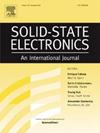Cobalt-doped zinc sulfide quantum dot thin films for next-generation electronic devices: Synthesis, characterization, and switching properties
IF 1.4
4区 物理与天体物理
Q3 ENGINEERING, ELECTRICAL & ELECTRONIC
引用次数: 0
Abstract
In this communication we comprehensively study the synthesis and characterization of Cobalt-doped ZnS quantum dots with controlled size and composition as a possible candidate for Resistive random access memory (RRAM). The pristine ZnS QDs and ZnS QDs with 10 % and 15 % cobalt doped are synthesized using sol- gel process. The basic characterization XRD and TEM confirms the formation of the material, and their particle size is found to be between 4.14 nm to 5.93 nm. The band gap of the particles is found out using UV–Visible Spectroscopy. Further, Polyvinyl alcohol (PVA) polymer composite solutions are prepared using synthesized QDs. Further, their thin films are deposited through spin coating technique and their corresponding devices ITO/PVA/Ag, ITO/Co (10 %)-ZnS QDs: PVA/Ag and ITO/Co (15 %)-ZnS QDs: PVA/Ag are fabricated. The current–voltage (I-V) measurements revealed the existence of resistive switching in all devices. Regardless of the direction of the voltage sweep, the device will exhibit write-once-read-many (WORM) memory behavior as a result of the incorporation of Co-ZnS QDs into the PVA matrix. A noticeable and enhanced resistive switching behavior in the devices was the outcome of the increased cobalt doping. The ITO/Co (15 %)-ZnS QDs: PVA/Ag device displayed an ON/OFF ratio of one order with a good data retention of 2000 s and endurance of about 2000 cycles. Ultimately, the I-V fitting demonstrates that the WORM memory in the devices is caused by the space charge area that forms at the interface between the electrode and the active material.
用于下一代电子器件的钴掺杂硫化锌量子点薄膜:合成、表征和开关特性
在本文中,我们全面研究了具有可控尺寸和组成的钴掺杂ZnS量子点的合成和表征,作为电阻随机存取存储器(RRAM)的可能候选者。采用溶胶-凝胶法制备了原始ZnS量子点和掺杂10%和15%钴的ZnS量子点。XRD和TEM的基本表征证实了材料的形成,发现其粒径在4.14 ~ 5.93 nm之间。用紫外-可见光谱法测定了粒子的带隙。此外,利用合成的量子点制备了聚乙烯醇(PVA)聚合物复合溶液。在此基础上,采用自旋镀膜技术制备了ITO/PVA/Ag、ITO/Co (10%)-ZnS QDs: PVA/Ag和ITO/Co (15%)-ZnS QDs: PVA/Ag器件。电流-电压(I-V)测量揭示了所有器件中都存在阻性开关。无论电压扫描的方向如何,由于将Co-ZnS量子点结合到PVA矩阵中,该器件都将表现出写一次读多次(WORM)的记忆行为。器件中明显增强的电阻开关行为是增加钴掺杂的结果。ITO/Co (15%)-ZnS QDs: PVA/Ag器件显示出一个数量级的开/关比,良好的数据保留时间为2000 s,续航时间约为2000次。最终,I-V拟合表明,器件中的WORM记忆是由电极和活性材料之间的界面上形成的空间电荷区引起的。
本文章由计算机程序翻译,如有差异,请以英文原文为准。
求助全文
约1分钟内获得全文
求助全文
来源期刊

Solid-state Electronics
物理-工程:电子与电气
CiteScore
3.00
自引率
5.90%
发文量
212
审稿时长
3 months
期刊介绍:
It is the aim of this journal to bring together in one publication outstanding papers reporting new and original work in the following areas: (1) applications of solid-state physics and technology to electronics and optoelectronics, including theory and device design; (2) optical, electrical, morphological characterization techniques and parameter extraction of devices; (3) fabrication of semiconductor devices, and also device-related materials growth, measurement and evaluation; (4) the physics and modeling of submicron and nanoscale microelectronic and optoelectronic devices, including processing, measurement, and performance evaluation; (5) applications of numerical methods to the modeling and simulation of solid-state devices and processes; and (6) nanoscale electronic and optoelectronic devices, photovoltaics, sensors, and MEMS based on semiconductor and alternative electronic materials; (7) synthesis and electrooptical properties of materials for novel devices.
 求助内容:
求助内容: 应助结果提醒方式:
应助结果提醒方式:


